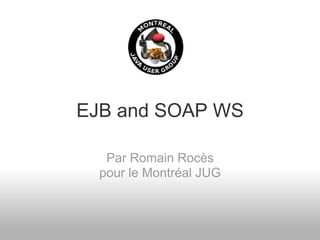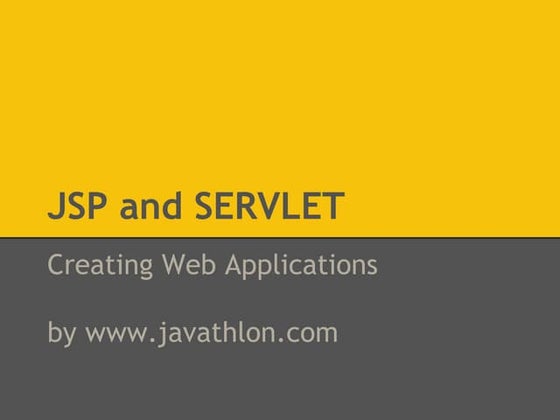EJB et WS (Montreal JUG - 12 mai 2011)
- 1. EJB and SOAP WS Par Romain Roc¨¨s pour le Montr¨¦al JUG
- 2. About me Romain Roc¨¨s Teacher at Supinfo Montreal Blue belt on BlackBelt Factory romain.roces@gmail.com Romain Roc¨¨s
- 3. Concept
- 4. Concept EJB regroups several concepts Provides different services (Session Bean), communicates with another application (Message Bean), saves information (Entity Bean). Just like a brain, EJB is the center of the application. It proposes many functions.
- 5. Version 3 The previous version (2.1) was too complex The version 3.0 tends to simplification : Less steps, less classes, less configuration Improvements from Java EE 5 Annotations Generics Java Persistance API Concepts remain the same, but Sun integrated many ideas from popular open-source projects like Spring or Hibernate.
- 6. Application servers WebLogic, by BEA Oracle Application Server, by Oracle JBoss, by RedHat GlassFish, by Sun MicroSystems
- 7. EJB session Singleton, Stateless, Stateful
- 8. Facade pattern The Session Bean acts as a ˇ°facadeˇ±. It's the client's interlocutor
- 9. Client access Different clients can call the Session Bean methods if they possess its interface Desktop application Interface Implementation Session Bean deployed on a server Web application
- 12. Session Bean Local Set @Local on the interface (not mandatory) Used when the client is deployed in the same virtual machine Example : A Web application deployed in the same server as the Session Bean Advantage : Resource-friendly More secure Disadvantage : Local scope
- 13. Session Bean Local Local interfaces are not mandatory @Stateless public class HelloServiceBean { public String sayHello(){ return "Hello World"; } }
- 14. Session Bean Remote Set @Remote on the interface Used when the client is located in a different virtual machine Example : A web application deployed in a different server than the Session Bean A rich-client Advantage : Open on the network Disadvantage : Consumes more resources (uses RMI) Security
- 15. Session Bean Remote Interface @Remote public interface HelloService { public String sayHello(); } Implementation @Stateless public class HelloServiceBean implements HelloService{ public String sayHello(){ return "Hello World"; } }
- 16. Stateless mode A Stateless Bean is not bound to any client Exemples : Retrieve a list of products HelloService getPlaces() getPlaces() Advantage : getTrips() Resource-friendly
- 17. Stateless mode @Stateless public class HelloWorld { public String sayHelloTo(String name){ return "Hello " + name; } }
- 18. Stateful mode A Statefull Bean is bound to a client Exemples : Cart OrderService getPlaces() getPlaces() Advantage : getTrips() Impact on server performance
- 19. Stateful mode @Stateful public class OrderService { public void setName(String name){ˇ}; public void setAddress(String address){ˇ}; public void buyDog(){ˇ}; ˇ }
- 20. Singleton mode One Singleton Bean per JVM Exemples : Counter Cache Advantage : Resource-friendly One instance Disadvantage : One instance
- 21. Singleton mode @Singleton public class Counter { private int i = 0; public int getCount(){ return ++i; } }
- 22. Asynchronous calls How to have asynchronous call in EJBs ? Threads don't integrate well @Asynchronous Method returns void or java.util.concurrent.Future<T>
- 23. Asynchronous calls @Stateless public class HelloWorld { @EJB MailManager mailManager; public String sayHelloTo(String name){ mailManager.sendMail(); return "Hello " + name; } } @Stateless public class MailManager { @Asynchronous public void sendMail(){ ... } }
- 24. Timer Service Programmatic and Calendar based scheduling ? Last day of the month ? ? Every five minutes on Monday and Friday ? Cron-like syntax second [0..59], minute[0..59], hour[0..23], year DayOfMonth[1..31] dayOfWeek[0..7] or [sun, mon, tue..] Month[0..12] or [jan,feb..]
- 25. Timer Service @Stateless public class WakeUpBean { @Schedule(dayOfWeek=ˇ°Mon-Friˇ±, hour=ˇ°9ˇ±) void wakeUp() { ... } }
- 26. Unit Test
- 27. JUnit Not in EJB context @Test public void myTest(){ StatelessBean statelessBean = new StatelessBean(); statelessBean.getCounter(); }
- 28. JUnit With EJB context : embedded glassfish @Test public void myTest() throws NamingException{ EJBContainer createEJBContainer = EJBContainer.createEJBContainer(); StatelessBean statelessBean = (StatelessBean)container.getContext() .lookup("java:global/classes/StatelessBean"); statelessBean.getCounter(); container.close(); }
- 29. Unit Test Cactus is a simple test framework for unit testing server-side java code (Servlets, EJBs, Tag Libs, Filters, ...). The Ejb3Unit project automates Entity and Session bean testing outside the container for the EJB 3.0 specification.
- 30. Client connection lookup & @EJB
- 31. EJB connection with lookup The client needs the JNDI context to connect to the server. The client also needs the Session Bean interface Retrieve the Session Bean with a lookup() Then it's possible to call methods from the Bean Context context = new InitialContext(); HelloService hello = (HelloService) context.lookup(HelloService.class.getName()); System.out.println(hello.sayHello()); The Session Bean will send you a message !
- 32. EJB connection with lookup jndi.properties file example GlassFish parameters java.naming.factory.initial=com.sun.enterprise.naming.SerialInitContextFactory java.naming.factory.url.pkgs=com.sun.enterprise.naming java.naming.factory.state=com.sun.corba.ee.impl.presentation.rmi.JNDIStateFactoryImpl JBoss Parameters java.naming.factory.initial=org.jnp.interfaces.NamingContextFactory java.naming.factory.url.pkgs=org.jboss.naming:org.jnp.interfaces java.naming.provider.url = 127.0.0.1:1099
- 33. EJB injection In the same JVM, it's not necessary to do a lookup() Obtain a Session Bean with resource injection Used in other EJBs, web applications public class ClientServiceBean implements ClientService { @EJB private OrderService orderService; ... }
- 34. Soap WS in EJB module Add @WebService and @Stateless annotation on a class It run ! @WebService @Stateless public class MyBeanPublic { @WebMethod public String helloWorld() { return null; } } Default WSDL address : http://localhost: 8080/MyBeanPublicService/MyBeanPublic?wsdl
- 35. Soap WS in EJB module Now, we use our EJB @stateless in our SOAP WS. @WebService @Stateless public class MyBeanPublic { @EJB private MyBeanLocal ejbRef; @WebMethod public String helloWorld() { return ejbRef.helloWorld(); } }
- 36. Soap WS in EJB module Exemple with NetBeans 7
- 37. EJB entity
- 38. Persistence Unit The persistence unit makes the link between your application and a DataSource
- 39. Persistence Unit Different providers Hibernate (use by default in JBoss) TopLink (use by default in Glassfish v2) EclipseLink (use by default in Glassfish v3)
- 40. Persistence Unit persistence.xml <?xml version="1.0" encoding="UTF-8"?> <persistence version="2.0" ...> <persistence-unit name="montrealjugPU" transaction-type="JTA"> <provider>org.eclipse.persistence.jpa.PersistenceProvider</provider> <jta-data-source>jdbc/firone</jta-data-source> <exclude-unlisted-classes>false</exclude-unlisted-classes> <properties> <property name="eclipselink.ddl-generation" value="create-tables"/> </properties> </persistence-unit> </persistence>
- 41. Persistence Unit glassfish-resources.xml <?xml version="1.0" encoding="UTF-8"?> <!DOCTYPE resources PUBLIC "-//GlassFish.org//DTD GlassFish Application Server 3.1 Resource Definitions//EN" "http://glassfish.org/dtds/glassfish-resources_1_5.dtd"> <resources> <jdbc-connection-pool ...> <property name="serverName" value="localhost"/> <property name="portNumber" value="1527"/> <property name="databaseName" value="firone"/> <property name="User" value="firone"/> <property name="Password" value="firone"/> <property name="URL" value="jdbc:derby://localhost:1527/firone"/> <property name="driverClass" value="org.apache.derby.jdbc.ClientDriver"/> </jdbc-connection-pool> <jdbc-resource enabled="true" jndi-name="jdbc/firone" object-type="user" pool-name=" derby_net_firone_fironePool"/> </resources>
- 42. EntityManager in EJB Obtain an EntityManager with injection @Stateless public class DAO { @PersistenceContext(unitName="montrealjugPU") protected EntityManager em; public void createCat(Cat cat){ em.persist(cat); } }
- 43. EJB message Java Message Service
- 44. JMS presentation The same since 2002 Used when some information should be exchanged between Two applications : point-to-point model Several applications : publish and subscribe model Asynchronous system : messages are received when the client request them Similar to a mail system
- 45. Queue mode
- 46. Topic mode
- 47. Messages There are three different types of messages TextMessage to send simple text ObjectMessage for a serialized object MapMessage contains a map with strings as keys and objects as values
- 48. Send a message In order to send a message, we have to: Reclaim required objects via JNDI A ConnectionFactory (service provider) A Destination (Queue or Topic) Create a Connection using the factory Open a Session using the connection Create a MessageProducer Send the message
- 49. Send a message Context ctx = new InitialContext(); ConnectionFactory connectionFactory = (ConnectionFactory) ctx .lookup("ConnectionFactory"); Destination destination = (Destination) ctx.lookup("queue/StockValue"); Connection cnx = connectionFactory.createConnection(); Session session = cnx.createSession(false, Session.AUTO_ACKNOWLEDGE); MessageProducer producer = session.createProducer(destination); TextMessage message = session.createTextMessage(); message.setText("Your'microsoft' stock has been sold !"); producer.send(message); cnx.close();
- 50. Receive a message Two ways to receive a message Blocking, waiting for a message Non-blocking, using a message listener A message listener is similar to an event listener : it "subscribes" to a particular destination and receives messages each time there's a new one
- 51. Receive a message Blocking mode MessageConsumer consumer = session.createConsumer (destination); // Retrieve a single message Message receivedMessage = consumer.receive(); Non-blocking mode, using a listener MessageConsumer consumer = session.createConsumer(destination); // Set the listener consumer.setMessageListener(new MessageListener() { public void onMessage(Message message) { // Will be called each time a message is received } });
- 52. Receive a message : Message Driven Bean A Message Driven Bean is a specific component for receiving messages Annotation used is @MessageDriven Destination name and type are declared in the annotation Implements javax.jms.MessageListener Method public void onMessage(Message m) Called at the moment of receipt
- 53. Receive a message : Message Driven Bean @MessageDriven( mappedName="queue/StockValue", activationConfig = { @ActivationConfigProperty( propertyName = "destinationType", propertyValue = "javax.jms.Queue")}) class MyDrivenBean implements MessageListener { public void onMessage(Message message) { TextMessage textMessage = (TextMessage) message; System.out.println(textMessage.getText()); } }
- 54. Merci de votre attention
- 55. Sources Supinfo : www.supinfo.com ParisJUG : www.parisjug.org























![Timer Service
Programmatic and Calendar based scheduling
? Last day of the month ?
? Every five minutes on Monday and Friday ?
Cron-like syntax
second [0..59], minute[0..59], hour[0..23], year
DayOfMonth[1..31]
dayOfWeek[0..7] or [sun, mon, tue..]
Month[0..12] or [jan,feb..]](https://image.slidesharecdn.com/ejbetws-110514152756-phpapp02/85/EJB-et-WS-Montreal-JUG-12-mai-2011-24-320.jpg)





































![Java Web Programming [2/9] : Servlet Basic](https://cdn.slidesharecdn.com/ss_thumbnails/javaweb-module2-130106070240-phpapp02-thumbnail.jpg?width=560&fit=bounds)






![Java Web Programming [5/9] : EL, JSTL and Custom Tags](https://cdn.slidesharecdn.com/ss_thumbnails/javaweb-module5-130106070631-phpapp02-thumbnail.jpg?width=560&fit=bounds)

![Java Web Programming [8/9] : JSF and AJAX](https://cdn.slidesharecdn.com/ss_thumbnails/javaweb-module8-130106070914-phpapp02-thumbnail.jpg?width=560&fit=bounds)






![Java Web Programming [3/9] : Servlet Advanced](https://cdn.slidesharecdn.com/ss_thumbnails/javaweb-module3-130106070352-phpapp02-thumbnail.jpg?width=560&fit=bounds)








![Appasaheb Kapase[CV]](https://cdn.slidesharecdn.com/ss_thumbnails/7624e215-ecb7-4e7d-9102-8e0460020368-141213130455-conversion-gate01-thumbnail.jpg?width=560&fit=bounds)



























